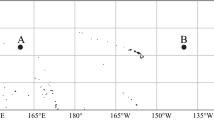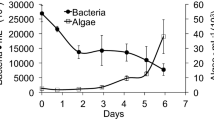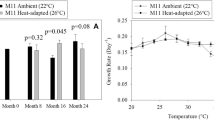Abstract
Blooms of Nostocales (Cyanobacteria) are thought to be invading subtropical and temperate water bodies. According to nutrient stoichiometry and physiological differences between cyanobacterial groups, the replacement of non-heterocystous species by Nostocales is favored when dissolved inorganic nitrogen decreases. However, some studies have shown different trends. We used laboratory bioassays to evaluate the concomitant effects of light and nutrient enrichment on phytoplankton assemblages dominated by non-heterocystous filamentous cyanobacteria. Three nutrient conditions (no addition, addition of phosphate, and addition of nitrate and phosphate) and two light intensities (40 and 80 µmol photon m−2 s−1) were assayed. Nostocales replaced or co-dominated with non-heterocystous species in all treatments by the end of the study. The shift in community composition towards Nostocales dominance led to an increase in species richness, which suggests that species with different eco-physiological traits may have differential impacts on diversity. The highest saxitoxin concentrations were measured in no addition treatments, which could link production to nutritional stress. Nostocales featured high phenotypic plasticity in terms of changes in average trichome volume and growth rates. These results help to have a better understanding of the conditions under which Nostocales predominance can occur.






Similar content being viewed by others
References
Agawin, N. S. R., S. Rabouille, M. J. W. Veldhuis, L. Servatius, S. Hol, H. M. J. van Overzee & J. Huisman, 2007. Competition and facilitation between unicellular nitrogen-fixing cyanobacteria and non—nitrogen-fixing phytoplankton species. Limnology and Oceanography 52: 2233–2248.
Agrawal, A. A., 2001. Phenotypic plasticity in the interactions and evolution of species. Science 294: 321–326.
Amaral, V., S. Bonilla & L. Aubriot, 2014. Growth optimization of the invasive cyanobacterium Cylindrospermopsis raciborskii in response to phosphate fluctuations. European Journal of Phycology 49: 134–141.
Antunes, J. T., P. N. Leão & V. M. Vasconcelos, 2015. Cylindrospermopsis raciborskii: review of the distribution, phylogeography, and ecophysiology of a global invasive species. Frontiers in Microbiology 6: 473.
Aubriot, L. & S. Bonilla, 2012. Rapid regulation of phosphate uptake in freshwater cyanobacterial blooms. Aquatic Microbiological Ecology 67: 251–263.
Beamud, G., P. Vico, S. Haakonsson, G. Martínez de la Escalera, C. Piccini, B. Brena, M. Pirez & S. Bonilla, 2015. Influence of UV-B radiation on the fitness and toxin expression of the cyanobacterium Cylindrospermopsis raciborskii. Hydrobiologia 763: 161–172.
Blanch, H. W. & D. S. Clark, 1996. Biochemical Engineering. Marcel Dekker Inc, New York.
Bonilla, S., L. Aubriot, M. C. S. Soares, M. González-Piana, A. Fabre, V. L. M. Huszar, M. Lürling, D. Antoniades, J. Padisák & C. Kruk, 2012. What drives the distribution of the bloom-forming cyanobacteria Planktothrix agardhii and Cylindrospermopsis raciborskii? FEMS Microbiology Ecology 79: 594–607.
Bonilla, S., M. González-Piana, M. C. S. Soares, V. L. M. Huszar, V. Becker, A. Somma, M. M. Marinho, M. Kokociński, M. Dokulil, D. Antoniades & L. Aubriot, 2016. The success of the cyanobacterium Cylindrospermopsis raciborskii in freshwaters is enhanced by the combined effects of light intensity and temperature. Journal of Limnology 75: 606–617.
Bradburn, M. J., W. M. Lewis Jr. & J. H. McCutchan Jr., 2012. Comparative adaptations of Aphanizomenon and Anabaena for nitrogen fixation under weak irradiance. Freshwater Biology 57: 1042–1049.
Burford, M. A., T. W. Davis, P. T. Orr, R. Sinha, A. Willis & B. A. Neilan, 2014. Nutrient-related changes in the toxicity of field blooms of the cyanobacterium Cylindrospermopsis raciborskii. FEMS Microbiology Ecology 89: 135–148.
Burford, M. A., J. Beardall, A. Willis, P. T. Orr, V. F. Magalhaes, L. M. Rangel, S. M. F. O. E. Azevedo & B. A. Neilan, 2016. Understanding the winning strategies used by the bloom-forming cyanobacterium Cylindrospermopsis raciborskii. Harmful Algae 54: 44–53.
Carey, C. C., B. W. Ibelings, E. P. Hoffmann, D. P. Hamilton & J. D. Brookes, 2012. Eco-physiological adaptations that favour freshwater cyanobacteria in a changing climate. Water Research 46: 1394–1407.
Carneiro, R. L., M. E. V. dos Santos, A. B. F. Pacheco & S. M. F. O. Azevedo, 2009. Effects of light intensity and light quality on growth and circadian rhythm of saxitoxins production in Cylindrospermopsis raciborskii (Cyanobacteria). Journal of Plankton Research 31: 481–488.
Casero, M. C., A. Ballot, R. Agha, A. Quesada & S. Cirés, 2014. Characterization of saxitoxin production and release and phylogeny of sxt genes in paralytic shellfish poisoning toxin-producing Aphanizomenon gracile. Harmful Algae 37: 28–37.
Chislock, M. F., K. L. Sharp & A. E. Wilson, 2014. Cylindrospermopsis raciborskii dominates under very low and high nitrogen-to-phosphorus ratios. Water Research 49: 207–214.
Cirés, S. & A. Ballot, 2016. A review of the phylogeny, ecology and toxin production of bloom-forming Aphanizomenon spp. and related species within the Nostocales (cyanobacteria). Harmful Algae 54: 21–43.
Crossetti, L. O., D. C. Bicudo, C. E. M. Bicudo & L. M. Bini, 2008. Phytoplankton biodiversity changes in a shallow tropical reservoir during the hypertrophication process. Brazilian Journal of Biology 68: 1061–1067.
Daehler, C. C. & D. R. Strong, 1996. Can you bottle nature? The roles of microcosms in ecological research. Ecology 77: 663–664.
Davis, T. W., G. S. Bullerjahn, T. Tuttle, R. M. McKay & S. B. Watson, 2015. Effects of increasing nitrogen and phosphorus concentrations on phytoplankton community growth and toxicity during Planktothrix blooms in Sandusky Bay, Lake Erie. Environmental Science & Technology 49: 7197–7207.
De Figueiredo, D. R., A. S. S. P. Reboleira, S. C. Antunes, N. Abrantes, U. Azeiteiro, F. Gonçalves & M. J. Pereira, 2006. The effect of environmental parameters and cyanobacterial blooms on phytoplankton dynamics of a Portuguese temperate Lake. Hydrobiologia 568: 145–157.
de Tezanos Pinto, P. & E. Litchman, 2010. Interactive effects of N:P ratios and light on nitrogen-fixer abundance. Oikos 119: 567–575.
Dickman, E. M., M. J. Vanni & M. J. Horgan, 2006. Interactive effects of light and nutrients on phytoplankton stoichiometry. Oecologia 149: 676–689.
Dolman, A. M., J. Rücker, F. R. Rick, J. Fastner, T. Rohrlack, U. Mischke & C. Wiedner, 2012. Cyanobacteria and cyanotoxins: the influence of nitrogen versus phosphorus. PLoS ONE 7: e38757.
Donald, D. B., M. J. Bogard, K. Finlay, L. Bunting & P. R. Leavitt, 2013. Phytoplankton-specific response to enrichment of phosphorus-rich surface waters with ammonium, nitrate, and urea. PLoS ONE 8: e53277.
Fabre, A., C. Carballo, E. Hernández, P. Piriz, L. Bergamino, L. Mello, S. González, G. Pérez, J. G. León, L. Aubriot, S. Bonilla & C. Kruk, 2010. El nitrógeno y la relación zona eufótica/zona de mezcla explican la presencia de cianobacterias en pequeños lagos subtropicales, artificiales de Uruguay. Pan-American Journal of Aquatic Sciences 5: 112–125.
Hennemann, M. C. & M. M. Petrucio, 2016. High chlorophyll a concentration in a low nutrient context: discussions in a subtropical lake dominated by Cyanobacteria. Journal of Limnology 75: 520–530.
Harke, M. J., T. W. Davis, S. B. Watson & C. J. Gobler, 2016. Nutrient-controlled niche differentiation of Western Lake Erie cyanobacterial populations revealed via metatranscriptomic surveys. Environmental Science & Technology 50: 604–615.
Havens, K. E., R. T. James, T. L. East & V. H. Smith, 2003. N:P ratios, light limitation, and cyanobacterial dominance in a subtropical lake impacted by non-point source nutrient pollution. Environmental Pollution 122: 379–390.
Hillebrand, H., C. D. Dürselen, D. Kirschtel, U. Pollingher & T. Zohary, 1999. Biovolume calculation for pelagic and benthic microalgae. Journal of Phycology 35: 403–424.
Holland, A. & S. Kinnear, 2013. Interpreting the possible ecological role(s) of cyanotoxins: compounds for competitive advantage and/or physiological aide? Marine Drugs 11: 2239–2258.
Howarth, R. W., R. Marino & J. J. Cole, 1988. Nitrogen fixation in freshwater, estuarine, and marine ecosystems. 2. Biogeochemical control. Limnology and Oceanography 33: 688–701.
ISO, 1992. Water Quality Measurement of Biochemical Parameters Spectrophotometric Determination of Chlorophyll-a Concentration. International Organization for Standardization, Geneva: 1–6.
Istvánovics, V., H. M. Shafik, M. Présing & S. Juhos, 2000. Growth and phosphate uptake kinetics of the cyanobacterium, Cylindrospermopsis raciborskii (Cyanophyceae) in through flow cultures. Freshwater Biology 43: 257–275.
Jost, L., 2007. Partitioning diversity into independent alpha and beta components. Ecology 88: 2427–2439.
Kaplan-Levy, R. N., O. Hadas, M. L. Summers, J. Rücker & A. Sukenik, 2010. Akinetes: dormant cells of Cyanobacteria. In Lubzens, E., J. Cerda & M. Clark (eds), Dormancy and resistance in harsh environments. Springer, Berlin: 5–27.
Kenesi, G., H. M. Shafik, A. W. Kovács, S. Herodek & M. Présing, 2008. Effect of nitrogen forms on growth, cell composition and N2 fixation of Cylindrospermopsis raciborskii in phosphorus-limited chemostat cultures. Hydrobiologia 623: 191–202.
Kirk, J., 2011. Light and photosynthesis in aquatic ecosystems. Cambridge University Press, New York.
Kokociński, M., K. Stefaniak, J. Mankiewicz-Boczek, K. Izydorczyk & J. Soininen, 2010. The ecology of the invasive cyanobacterium Cylindrospermopsis raciborskii (Nostocales, Cyanophyta) in two hypereutrophic lakes dominated by Planktothrix agardhii (Oscillatoriales, Cyanophyta). European Journal of Phycology 45: 365–374.
Komárek, J., J. Kaštovský, J. Mareš & J. R. Johansen, 2014. Taxonomic classification of cyanoprokaryotes (cyanobacterial genera) 2014, using a polyphasic approach. Preslia 86: 295–335.
Koroleff, F., 1970. Revised version of “Direct determination of ammonia in natural waters as indophenol blue”. The International Council for the Exploration of the Sea C. M. 1969/C:9 ICES information on techniques and methods for sea water analysis. Interlaboratory Report No. 3, 19–22
Levine, S. N. & D. W. Schindler, 1999. Influence of nitrogen to phosphorus supply ratios and physicochemical conditions on cyanobacteria and phytoplankton species composition in the Experimental Lakes Area, Canada. Canadian Journal of Fisheries and Aquatic Sciences 56: 451–466.
Mantzouki, E., P. M. Visser, M. Bormans & B. W. Ibelings, 2015. Understanding the key ecological traits of cyanobacteria as a basis for their management and control in changing lakes. Aquatic Ecology 50: 333–350.
Miner, B. G., S. E. Sultan, S. G. Morgan, D. K. Padilla & R. A. Relyea, 2005. Ecological consequences of phenotypic plasticity. Trends in Ecology & Evolution 20: 685–692.
Mischke, U., 2003. Cyanobacteria associations in shallow polytrophic lakes: influence of environmental factors. Acta Oecologica 24: S11–S23.
Moisander, P. H., H. W. Paerl & J. P. Zehr, 2008. Effects of inorganic nitrogen on taxa-specific cyanobacterial growth and nifH expression in a subtropical estuary. Limnology and Oceanography 53: 2519–2532.
Muhid, P., T. W. Davis, S. E. Bunn & M. A. Burford, 2013. Effects of inorganic nutrients in recycled water on freshwater phytoplankton biomass and composition. Water Research 47: 384–394.
Müller, R. & F. Widemann, 1955. Die bestimmung des nitrats in wasser. Jahrb. Wasserchem. Wasserreinigungstechnik. Verlag Chimie 12: 247–271.
Murphy, J. & J. P. Riley, 1962. A modified single solution method for the determination of phosphate in natural waters. Analytica Chimica Acta 27: 31–36.
Neilan, B. A., L. A. Pearson, J. Muenchhoff, M. C. Moffitt & E. Dittmann, 2013. Environmental conditions that influence toxin biosynthesis in cyanobacteria. Environmental Microbiology 15: 1239–1253.
Nicholson, B. C., M. D. Burch, 2001. Evaluation of analytical methods for detection and quantification of cyanotoxins in relation to Australian drinking water guidelines, a report prepared for the National Health and Medical Research Council of Australia, the Water Services Association of Australia, and the Cooperative Research Centre for Water Quality and Treatment.
Olli, K., R. Klais & T. Tamminen, 2015. Rehabilitating the cyanobacteria – niche partitioning, resource use efficiency, and phytoplankton community structure during diazotrophic cyanobacterial blooms. Journal of Ecology 103: 1153–1164.
O’Neil, J. M., T. W. Davis, M. A. Burford & C. J. Gobler, 2012. The rise of harmful cyanobacteria blooms: the potential roles of eutrophication and climate change. Harmful Algae 14: 313–334.
Olsen, L. M., M. Öztürk, E. Sakshaug & J. Geir, 2006. Photosynthesis-induced phosphate precipitation in seawater: ecological implications for phytoplankton. Marine Ecology Progress Series 319: 103–110.
Paerl, H. W. & T. G. Otten, 2013. Harmful cyanobacterial blooms: causes, consequences, and controls. Microbial Ecology 65: 995–1010.
Paerl, H. W. & T. G. Otten, 2016. Duelling “CyanoHABs”: unravelling the environmental drivers controlling dominance and succession among diazotrophic and non-N2-fixing harmful cyanobacteria. Environmental Microbiology 18: 316–324.
Paerl, H. W. & V. J. Paul, 2012. Climate change: links to global expansion of harmful cyanobacteria. Water Research 46: 1349–1363.
Paerl, H. W., R. S. Fulton 3rd, P. H. Moisander & J. Dyble, 2001. Harmful freshwater algal blooms, with an emphasis on cyanobacteria. Scientific World Journal 1: 76–113.
Paerl, H. W., H. Xu, N. S. Hall, G. Zhu, B. Qin, Y. Wu, K. L. Rossignol, L. Dong, M. J. McCarthy & A. R. Joyner, 2014. Controlling cyanobacterial blooms in hypertrophic Lake Taihu, China: will nitrogen reductions cause replacement of non-N(2) fixing by N(2) fixing taxa? PLoS ONE 9: e113123.
Pierangelini, M., S. Stojkovic, P. T. Orr & J. Beardall, 2015. Photo-acclimation to low light – changes from growth to antenna size in the cyanobacterium Cylindrospermopsis raciborskii. Harmful Algae 46: 11–17.
Pomati, F., B. A. Neilan, G. Manarolla, T. Suzuki & C. Rossetti, 2003. Enhancement of intracellular saxitoxin accumulation by lidocaine hydrochloride in the cyanobacterium Cylindrospermopsis raciborskii T3 (Nostocales). Journal of Phycology 39: 535–542.
Présing, M., S. Herodek, L. Vörös & I. Kóbor, 1996. Nitrogen fixation, ammonium and nitrate uptake during a bloom of Cylindrospermopsis raciborskii in Lake Balaton. Archiv für Hydrobiologie 136: 553–562.
Scheffer, M., S. Rinaldi, A. Gragnani, L. R. Mur & E. H. van Nes, 1997. On the dominance of filamentous cyanobacteria in shallow, turbid lakes. Ecology 78(1): 272–282.
Schindler, D. W., 2012. The dilemma of controlling cultural eutrophication of lakes. Proceeding of the Royal Society B Biological Sciences 279(1746): 4322–4333.
Schindler, D. W., R. E. Hecky, D. L. Findlay, M. P. Stainton, B. R. Parker, M. J. Paterson, K. G. Beaty, M. Lyng & S. E. M. Kasian, 2008. Eutrophication of lakes cannot be controlled by reducing nitrogen input: results of a 37-year whole-ecosystem experiment. Proceedings of the National Academy of Sciences 105: 11254–11258.
Schwaderer, A. S., K. Yoshiyama, P. de Tezanos Pinto, N. G. Swenson, C. A. Klausmeier & E. Litchman, 2011. Eco-evolutionary differences in light utilization traits and distributions of freshwater phytoplankton. Limnology and Oceanography 56: 589–598.
Shafik, H. M., L. Vörös, P. Spröber, M. Présing & A. W. Kovács, 2003. Some special morphological features of Cylindrospermopsis raciborskii in batch and continuous cultures. Hydrobiologia 506: 163–167.
Soares, M. C. S., M. Lürling & V. L. M. Huszar, 2013. Growth and temperature-related phenotypic plasticity in the cyanobacterium Cylindrospermopsis raciborskii. Phycological Research 61: 61–67.
Soto-Liebe, K., M. A. Méndez, L. Fuenzalida, B. Krock, A. Cembella & M. Vásquez, 2012. PSP toxin release from the cyanobacterium Raphidiopsis brookii D9 (Nostocales) can be induced by sodium and potassium ions. Toxicon 60: 1324–1334.
Statsoft Inc, 2004. STATISTICA (data analysis software). Tulsa, Oklahoma
Stucken, K., U. John, A. Cembella, K. Soto-Liebe & M. Vasquez, 2014. Impact of nitrogen sources on gene expression and toxin production in the diazotroph Cylindrospermopsis raciborskii CS-505 and non-diazotroph Raphidiopsis brookii D9. Toxins 6: 1896–1915.
Sukenik, A., O. Hadas, A. Kaplan & A. Quesada, 2012. Invasion of Nostocales (cyanobacteria) to subtropical and temperate freshwater lakes – physiological, regional, and global driving forces. Frontiers in Microbiology 3: 86.
Tilman, D., 1982. Resource competition and community structure. Monographs in Population Biology 17: 1–296.
Toporowska, M. & B. Pawlik-Skowrońska, 2014. Four-year study on phytoplankton biodiversity in a small hypertrophic lake affected by water blooms of toxigenic cyanobacteria. Polish Journal of Environmental Studies 23: 491–499.
Utermöhl, M., 1958. Zur Vervollkommung der quantitativen Phytoplankton Methodik. Mitteilungen Internationale Vereinigung Limnologie 9: 1–38.
Valderrama, J. C., 1981. The simultaneous analysis of total nitrogen and total phosphorus in natural waters. Marine Chemistry 10: 109–122.
Vico, P., L. Aubriot, F. Martigani, N. Rigamonti, S. Bonilla & C. Piccini, 2016. Influence of nitrogen availability on the expression of genes involved in the biosynthesis of saxitoxin and analogs in Cylindrospermopsis raciborskii. Harmful Algae 56: 37–43.
Vrede, T., A. Ballantyne, C. Mille-Lindblom, G. Algesten, C. Gudasz, S. Lindahl & A. K. Brunberg, 2009. Effects of N:P loading ratios on phytoplankton community composition, primary production and N fixation in a eutrophic lake. Freshwater Biology 54: 331–344.
Walve, J. & U. Larsson, 2007. Blooms of Baltic Sea Aphanizomenon sp. (Cyanobacteria) collapse after internal phosphorus depletion. Aquatic Microbial Ecology 49: 57–69.
Wiedner, C., B. Nixdorf, R. Heinze, B. Wirsing, U. Neumann & J. Weckesser, 2002. Regulation of cyanobacteria and microcystin dynamics in polymictic shallow lakes. Archiv für Hydrobiologie 155: 383–400.
Wu, Z., J. Shi & R. Li, 2009. Comparative studies on photosynthesis and phosphate metabolism of Cylindrospermopsis raciborskii with Microcystis aeruginosa and Aphanizomenon flos-aquae. Harmful Algae 8: 910–915.
Wetzel, R. G., 2001. Limnology. Academic Press, San Diego.
Acknowledgements
This work was financed by ANII_FCE6384, Uruguay and CONICET, Universidad Nacional de Mar del Plata (EXA743/15) and FIBA, Argentina. We thank Fátima Martigani and Federica Hirsch for technical assistance.
Author information
Authors and Affiliations
Corresponding author
Additional information
Handling editor: Boping Han
Electronic supplementary material
Below is the link to the electronic supplementary material.
10750_2017_3099_MOESM1_ESM.eps
Supplementary material 1 (EPS 5149 kb) S1 Nostocales: non-heterocystous species biovolume ratio under tested treatments. Bars represent mean ratio and standard deviation (n=3) for each nutrient treatment: no addition (A-B); addition of P (C-D); addition of N and P (E-F). Low light treatments (40 µmol photon m−2 s−1) are on the left and high light treatments (80 µmol photon m−2 s−1) on the right. Dash line denotes the ratio at T=0 (0.07)
10750_2017_3099_MOESM2_ESM.eps
Supplementary material 2 (EPS 998 kb) S2 Percentage of trichomes of Cylindrospermopsis raciborskii with heterocysts at the end of the experiment (T=11). Bars represent means and standard deviation (n=3) for each nutrient treatment. Values significantly different (two-way ANOVA, Holm-Sidak post hoc test p < 0.01) are marked with letter a
Rights and permissions
About this article
Cite this article
Aguilera, A., Aubriot, L., Echenique, R.O. et al. Synergistic effects of nutrients and light favor Nostocales over non-heterocystous cyanobacteria. Hydrobiologia 794, 241–255 (2017). https://doi.org/10.1007/s10750-017-3099-1
Received:
Revised:
Accepted:
Published:
Issue Date:
DOI: https://doi.org/10.1007/s10750-017-3099-1




